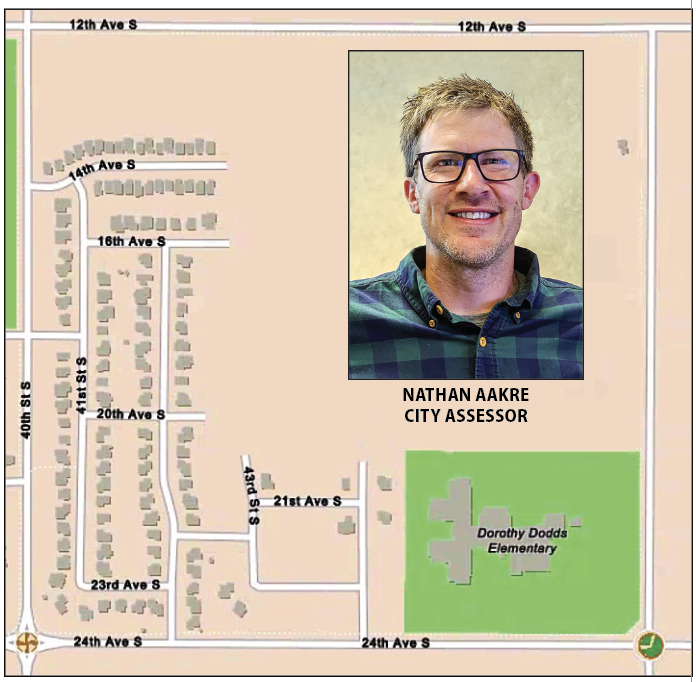
Moorhead’s residential property assessors will be working in the area between 40th Street South and Dorothy Dodds Elementary School.
Nancy Edmonds Hanson
Moorhead’s two residential tax assessors are knocking on doors and reviewing homes on the east side of the city. By the time autumn turns to winter, they will have assembled information on 20% of the single-family properties in Moorhead – some 2,500 of the city’s 12,500-odd houses – to set the baseline for next year’s property taxes.
Homeowners may not look forward to their every-five-years routine, but it’s a necessity, says Moorhead tax assessor Nathan Aakre. “Minnesota law requires us to view a quintile (one-fifth) of properties every year to maintain current property records.
“We review homes and their condition all summer and into the fall to get an accurate current picture. Then, when winter comes, we follow up on building permits and new construction, and do a deep dive into property sales in the city. How are properties selling across the city? Ultimately we use that data to set values across the city, adjusting our pricing tables according to those sales.
“Finally, in March, we send out valuation notices along with Clay County’s property tax statement.”
That knock on the door isn’t a homeowners’ first clue that their properties are being assessed. Instead, they got the alert earlier this year when Aakre’s department sent postcards to the neighborhoods earmarked for 2023. “We ask them to call us to schedule interviews with the assessors if they will allow it,” he says, describing the process. “Obviously, some don’t call for one reason or another.”
Yet that can’t slow the assessors down. They review the exterior of each house, take photographs and verify whatever they can from the outside.
Scheduled or not, they knock on the door, hoping to ask questions about what has changed inside since the last assessment five years before. Was the basement finished? Was the home remodeled? If no one answers the door, they leave their questions on a sticky note, asking the owner to either call and verify their answers or set up an appointment for a repeat visit.
“By law, the property owner has the right to not permit us into the interior of their home,” Aakre notes. “But then we’re allowed to make assumptions based on past inspection, the exterior, what’s typical for the neighborhood, and any building plans or permits that have been filed with the city.
“We do the best we can with the information we have available,” he says. Serious problems with accessing the answers they’re required to collect are rare, he adds: “Basically, we have a lot of good people here in Moorhead.”
Homeowners tend to dread the news that will come with their tax bill in March. That invoice from the Clay County Treasurer includes not only the city’s assessment but taxation by the county, Independent School District 152, the Moorhead Economic Development Authority and the Buffalo Watershed District. Special assessments are tucked in, too.
The statement includes the assessors’ conclusions about the value of the resident’s property as of Jan. 2, compared with its assessed value from the previous year. More often than not, the current year’s number is higher than it was 12 months before … and, therefore, most people expect – and dread – an increase in what they must pay.
Taxes do go up. But Aakre emphasizes that the simple fact of an increase in assessed value is not what boosts the amount due. Instead, the tax bill is based on the budgets set by the political subdivisions.
“The value of your property is not what directly drives your property tax bill,” he asserts. “It represents your share of how the tax burden has been divvied up.” In other words, if your property value has increased, chances are pretty good that your neighbors’ have, too. The proportion of the total tax revenue budgeted by the city, county and school system has not necessarily changed at all.
“If everyone’s valuations were cut in half, but the total tax burden remained the same, what you pay wouldn’t change much, if at all,” he emphasizes. “What you’re paying for is your share of all the services funded by those taxes – the cost of providing policing, fire protection, snowplows, parks, schools and everything else. If everyone’s property values doubled and those costs stayed the same, your property tax bill would stay the same, regardless of an increase in valuation.”
The department responsibilities include assessing the value of new homes that qualify for the two-year Make Moorhead Home tax rebate. They review properties while they are under construction, taxing them at their lower value as they take shape. Only after the project has concluded is the rebate applied, insuring that the owner gets the greatest possible return on the rebate deal.
Aakre, a native of Stephen, Minnesota, has directed the city’s tax department for six of his 10 years in the department. After graduating from Valley City State University in 2006, he worked in retail banking and mortgage with Wells Fargo and with Family Life Credit Services.
He heads a staff of five, including the two residential assessors, a generalist who also values apartments and commercial properties, and an administrator. All are accredited Minnesota assessors who have studied Minnesota laws and appraisal principles and procedures, culminating in interviews by the State Board of Assessors and a written test administered at the association’s headquarters in St. Michael.
For more information on assessment procedures and to contact the department, go to www.cityofmoorhead.com and search “assessing.”


